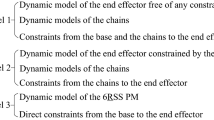Abstract
Optimal distribution of the actuating torques for a masticatory robot, which is in the form of a redundantly actuated parallel mechanism with two point-contact higher kinematic pairs (HKPs), is investigated in this paper. First, the mechanism of the robot is described, in which the two HKPs are used to model the temporomandibular joints between the condyles and the maxilla in the human masticatory system, and the six kinematic chains are used to model the six groups of the muscles of mastication. Then the inverse dynamics is studied using the Lagrange’s equations of the first type, resulting in the closed-form solution for the actuating torques. Considering the infinite solutions of the inverse dynamics for the actuating torque distribution in the redundantly actuated parallel robot, six optimal criteria that signify the practical performance of the robot are proposed. Finally, two simulations without and with bite force exerting to the teeth, respectively, given that the robot is specified to track a real human mandibular movement are conducted. Results are discussed and it is found that the dynamic performance of the robot varies significantly from one optimal criterion to another.


















Similar content being viewed by others
References
Xu, W.L., Bronlund, J.E., Potgieter, J., Foster, K.D., Rhrle, O., Pullan, A.J., Kieser, J.A.: Review of the human masticatory system and masticatory robotics. Mech. Mach. Theory 43(11), 1353–1375 (2008)
Lucas, P.W., Lucas, P.W.: The Basic Structure of the Mammalian Mouth Dental Functional Morphology. Cambridge University Press, Cambridge (2004)
Hannam, A.G., McMillan, A.S.: Internal organization in the human jaw muscles. Crit. Rev. Oral. Biol. Med. 5(1), 55–89 (1994)
Koolstra, J.H., van Eijden, T.M.G.J.: Three-dimensional dynamical capabilities of the human masticatory muscles. J. Biomech. 32(2), 145–152 (1999)
Takanobu, H., Takanishi, A., Ozawa, D., Ohtsuki, K., Ohnishi, M., Okino, A.: Integrated dental robot system for mouth opening and closing training. In: IEEE International Conference on Robotics and Automation, , pp. 1428–1433. Washington (2002)
Takanobu, H., Yajima, T., Nakazawa, M., Takanishi, A., Ohtsuki, K., Ohnishi, M.: Quantification of masticatory efficiency with a mastication robot. In: IEEE International Conference on Robotics and Automation, pp. 1635–1640. Leuven, Belgium (1998)
Sun, C., Xu, W.L., Bronlund, J.E., Morgenstern, M.: Dynamics and compliance control of a linkage robot for food chewing. IEEE Tran. Ind. Electron. 61(1), 377–386 (2014)
Xu, W.L., Torrance, J.D., Chen, B.Q., Potgieter, J., Bronlund, J.E., Pap, J.S.: Kinematics and experiments of a life-sized masticatory robot for characterizing food texture. IEEE Trans. Ind. Electron. 55(5), 2121–2132 (2008)
Takanobu, H., Maruyama, T., Takanishi, A., Ohtsuki, K., Ohnishi, M.: Mouth opening and closing training with 6-DOF parallel robot. In: IEEE International Conference on Robotics and Automation, pp. 1384–1389. San Francisco (2000)
Hayashi, T., Kato, S., Yamada, S., Nakajima, S., Yamada, Y., Kobayashi, H.: A physiological control of chewing-like jaw movement for robotized jaw simulator JSN/2A. In: Proceedings of the 22nd Annual International Conference of the IEEE Engineering in Medicine and Biology Society, pp. 730–731. Chicago (2000)
Zhao, Y.-S., Ren, J.-Y., Huang, Z.: Dynamic loads coordination for multiple cooperating robot manipulators. Mech. Mach. Theory 35(7), 985–995 (2000)
Müller, A., Maisser, P.: Generation and application of prestress in redundantly full-actuated parallel manipulators. Multibody Syst. Dyn. 18(2), 259–275 (2007)
Zhao, Y., Gao, F., Li, W., Liu, W., Zhao, X.: Development of 6-dof parallel seismic simulator with novel redundant actuation. Mechatronics 19(3), 422–427 (2009)
Abedinnasab, M., Vossoughi, G.R.: Analysis of a 6-DOF redundantly actuated 4-legged parallel mechanism. Nonlinear Dyn. 58(4), 611–622 (2009)
Shang, W., Cong, S.: Nonlinear adaptive task space control for a 2-DOF redundantly actuated parallel manipulator. Nonlinear Dyn. 59(1–2), 61–72 (2010)
Shang, W.-W., Cong, S., Ge, Y.: Adaptive computed torque control for a parallel manipulator with redundant actuation. Robotica 30(3), 457–466 (2012)
Shiqing, F., Franitza, D., Torlo, M., Bekes, F., Hiller, M.: Motion control of a tendon-based parallel manipulator using optimal tension distribution. IEEE/ASME Trans. Mechatron. 9(3), 561–568 (2004)
Nokleby, S.B., Fisher, R., Podhorodeski, R.P., Firmani, F.: Force capabilities of redundantly-actuated parallel manipulators. Mech. Mach. Theory 40(5), 578–599 (2005)
Zheng, Y.F., Luh, J.Y.S.: Optimal load distribution for two industrial robots handling a single object. In: IEEE International Conference on Robotics and Automation, pp. 344–349. Philadelphia (1988)
Nahon, M.A., Angeles, J.: Force optimization in redundantly-actuated closed kinematic chains. In: IEEE International Conference on Robotics and Automation, pp. 951–956. Scottsdale (1989)
Liu, J., Li, Y., Zhang, Y., Gao, Q., Zuo, B.: Dynamics and control of a parallel mechanism for active vibration isolation in space station. Nonlinear Dyn. 76(3), 1737–1751 (2014)
Mesnard, M., Coutant, J.C., Aoun, M., Morlier, J., Cid, M., Caix, P.: Relationships between geometry and kinematic characteristics in the temporomandibular joint. Comput. Methods Biomech. Biomed. Eng. 15(4), 393–400 (2011)
Siegler, S., Hayes, R., Nicolella, D., Fielding, A.: A technique to investigate the three-dimensional kinesiology of the human temporomandibular joint. J. Prosthet. Dent. 65(6), 833–839 (1991)
Tsai, L.-W.: Robot Analysis: The Mechanics of Serial and Parallel Manipulators. Wiley, New York (1999)
Shang, W.-W., Cong, S.: Motion control of parallel manipulators using acceleration feedback. IEEE Trans. Control Syst. Technol. 22(1), 314–321 (2014)
Xu, W., Bronlund, J.E.: Mastication Robots. Springer, Berlin (2010)
Acknowledgments
The first author sincerely acknowledges the financial support of the Doctoral Scholarship from China Scholarship Council.
Author information
Authors and Affiliations
Corresponding author
Rights and permissions
About this article
Cite this article
Cheng, C., Xu, W. & Shang, J. Optimal distribution of the actuating torques for a redundantly actuated masticatory robot with two higher kinematic pairs. Nonlinear Dyn 79, 1235–1255 (2015). https://doi.org/10.1007/s11071-014-1739-9
Received:
Accepted:
Published:
Issue Date:
DOI: https://doi.org/10.1007/s11071-014-1739-9




